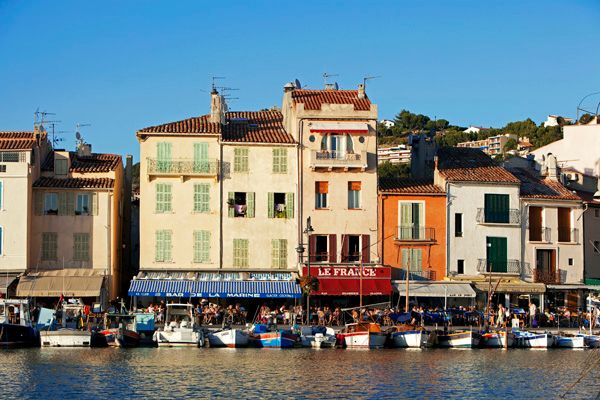With its steep-walled inlets, known locally as calanques, the stretch of coastline between Marseilles and Cassis is one of the most rugged landscapes of the whole of the Mediterranean. The spectacular, winding cliff-scape of the department of Bouches-du-Rhone in southern France is a sheer white limestone wall that plunges to the clear blue sea, forming delightful little coves that are perfect for swimming and diving.
Numerous trails lead to and along the cliff tops of the calanques, but some are so difficult to climb that the best way to admire and appreciate this natural marvel is simply to board one of the boats that run excursions along this stretch of French coastline and revel in the privilege of sharing the space with such species as Bonelli's eagle, the peregrine falcon and the eagle owl.
The itinerary begins in Cassis, one of the few fishing ports of the Riviera that has managed to maintain the same old-fashioned charm that once captured the imagination of artists such as Signac and Derain. Dominated by the impressive castle of the Counts of Baux, dating from Roman times, the appeal of this picturesque town is firmly rooted on the bright colours of the houses and boats, its landscape of vineyards and the fine white and rosé wines that are the perfect accompaniment to the superb seafood cuisine.
Taking the road towards Marseille, the first calanque you reach will be Port Miou. This is also the longest, stretching a kilometre and a half inland, as well as the most populated. Leaving behind the steep white walls dotted with spectacular villas and hanging gardens, you'll come to Port Pin, another beautiful stretch of bright water. From here on, the wild Massif des Calanques reveals itself in all its glory.
One of the most majestic of the inlets, well loved by climbers, is that of En-Vau, whose small white sand beach and crystal clear water leads to the Devil's Grotto, a cave carved by the waves over the course of centuries. Not far off stands the limestone ridged top of Castelviel, a truly spectacular sight from the sea. And then the cliffs rise, higher and higher, above the clear waters, reaching 460 metres at Grande Candella.
Suddenly you'll catch sight of the giddy heights of the cliffs that form the Devenson calanque, and then the Eye of Glass, a mighty rock eroded near the top of the limestone, whose reflective qualities has made it a marvellous natural lighthouse. With the rich perfume of the pine forest guiding you on, you'll reach Sormiou, les Goudes and Morgiou, three calanques used by Marseilles fishermen who fish their waters and sleep in small huts, some of which also serve as makeshift restaurants where you can enjoy a plate of the freshest sardines you'll ever taste. Beyond them, Marseilles stands at the end of this stretch of coast famed for its wild and unspoiled natural beauty.
THE PRACTICALITIES
Getting there The nearest airport is Marseilles.
Getting around Although renting a car will give you the freedom to explore the cliffs at your own pace, you should be aware that during the months of July and August the calanques of Morgiou of Sormiou are only accessible by land with a permit from Marseilles city council. The road does not always run along the coast, so perhaps the best way to discover the charms of the area, especially in summer, is by boat; excursions and tourist trips leave from either Cassis or Marseilles.
Best time to visit Spring and autumn are the two best times to enjoy the Massif des Calanques without the crowds of summer tourists, and they usually offer ideal weather for diving and climbing. In summer, the port of Cassis in particular gets very crowded, but even when busy, it is still is a lovely place.
Where to stay In Cassis, the Chateau de Cassis, is an old castle with nine beautifully refurbished rooms; perched on a cliff top, it offers great privacy in an area of stunning beauty. Also in Cassis, the Hotel des Roches Blanches at overhangs the cliff and the hotel's proximity to the Bestouan beach are two of its greatest attractions. Le Petit Nice-Passedat, a member of the Relais & Chateaux group, is one of the leading hotels in Marseilles.
Where to eatDining on the romantic terrace of Ville Madie, overlooking the Mediterranean at Cassis, is a unique and delightful experience that perfectly complements the avant-garde culinary creations. Located right at the Cassis marina since 1962, Nino is an ideal place to sample the freshest seafood and the famous local fish soup speciality - bouillabaisse. Located on the beautiful calanque of Morgiou, Nautic Bar offers delicious seafood in an incomparable setting. In Marseille, the restaurant of the Le Petit Nice-Passedat hotel sets the standard for luxury dining.
Don't missThe Massif des Calanques is a perfect location for getting started in both climbing and diving. In the Cassis Tourist Office offers information about active tourism companies operating in the area. For those interested in diving, there's the Centre Cassidain de Plongee. If you want to combine both activities, the Service Loisirs Accueil des Bouches-du-Rhone offers two-day excursions led by a qualified guide, which include climbing in the En-Vau calanque and diving in the underground caverns of Soubeyrannes.











